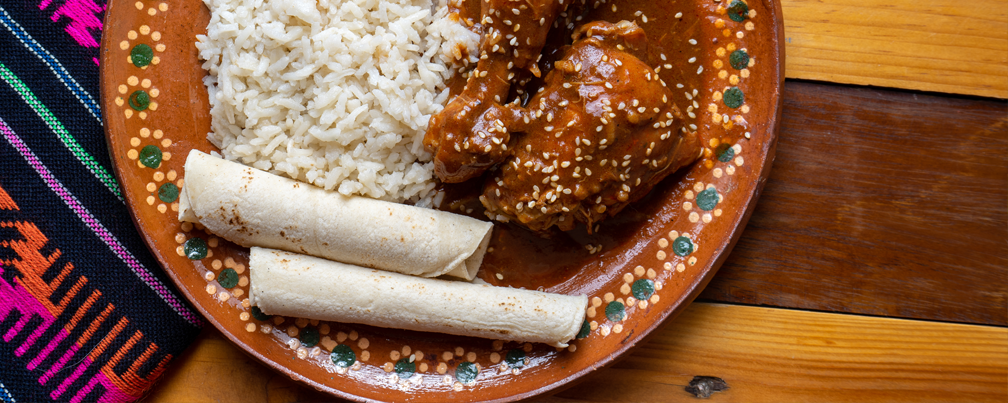Mole
Mole sauce is emblematic of Mexican cuisine. It is made from cocoa, dried chilli peppers, and corn, all roasted and ground before being mixed together and left to cook for several hours. Before the colonial period, the Aztecs served it to emperors and as an offering to the gods. However, the true origin of its recipe is uncertain. The most widely known mole is mole poblano, made from chilli peppers and cocoa, supposedly created in the 17th century by a nun from the Santa Rosa convent in Puebla.
The history of a divinely spicy sauce
Mole sauce, the epitome of Mexican food, is made from chilli peppers, cocoa and corn, and was already used before the colonial period as a filling for tortillas served at important meals. The name mole is derived from chilmolli in nahuatl, the language of the Aztecs, the word chil meaning chilli pepper and molli sauce or ragout.
The true origin of mole sauce is not clear, as there are a number of varying stories and recipes. However, all moles contain one or several kinds of dried chilli peppers (ancho, pasilla, chipotle, etc.), acidic fruit (tomatoes, green tomatoes, tamarind, etc.), sweet fruit (pears, plums, grapes, etc.), and spices (cinnamon, pepper, cloves, etc.) as well as thickeners (walnuts, tortillas, bread, etc.). Nowadays, mole is mainly served over meat, but also with vegetables or tortillas.
According to the conquistador Bernal Díaz, the emperor Moctezuma used to eat chilmolli from a terracotta dish. Rumour also has it that tribal chiefs greeted Hernán Cortès and his captains like princes when they landed in Mexico and served them this sauce, traditionally offered up to the gods.
The origin of the most widely known mole, mole poblano, made from chilli peppers and bitter cocoa, is disputed. A nun at the Santa Rosa convent in Puebla is said to have invented the recipe in the 17th century, when she heard of the impending visit of Juan de Palafox, Viceroy of New Spain and Archbishop of Puebla. To honour her guest, she emptied the larder, mixing indigenous ingredients (chilli peppers, tomatoes, cocoa, etc.) with products introduced by the conquistadors (onions, garlic, almonds, cloves, cinnamon). Another source claims this same nun invented it to mark the visit of Viceroy Tomás Antonio de la Cerda y Aragón, at the end of the 17th century. However, this recipe did not contain cocoa.
There are numerous other variations of mole besides mole poblano. Many come from the state of Oaxaca, such as the sweet and spicy mole negro, which contains chocolate, cloves, cinnamon and cumin. Other recipes include mole verde, made from pumpkin seeds and green chilli peppers, mole amarillo, made from yellow chilli peppers and mole manchamantel which contains fruit such as pineapple and plantain bananas, as well as more tangy ingredients such as chorizo, tomatoes and ancho chilli peppers.
The traditional method of making mole is as long as its list of ingredients! Each product is roasted, then ground with a pestle or on a metate stone, before being mixed, seasoned and cooked for several hours.
Following Mexico’s independence in 1821, mole became one of the symbols of Mexican cuisine. In fact, since 2010, all traditional Mexican cuisine, including mole, has featured on the UNESCO list of Intangible Cultural Heritage.
CASTILLO, Gilda (dir.), 2014. Mole: Fit for the Gods, Gentry’s Delight. México: Fundación Herdez
DELAPORTE, Ixchel, 2003. Cuisine mexicaine, la passion des épices. L’Humanité [online]. 29.03.2003. [Accessed on 04.12.2018]. Available on: https://www.humanite.fr/node/282369
Qué Gusto, Remonter l’histoire du Mexique sur la Route du Mole [online]. [Accessed on 04.12.2018]. ]. Available on: festivalquegusto.com/remonter-lhistoire-du-mexique-sur-la-route-du-mole









